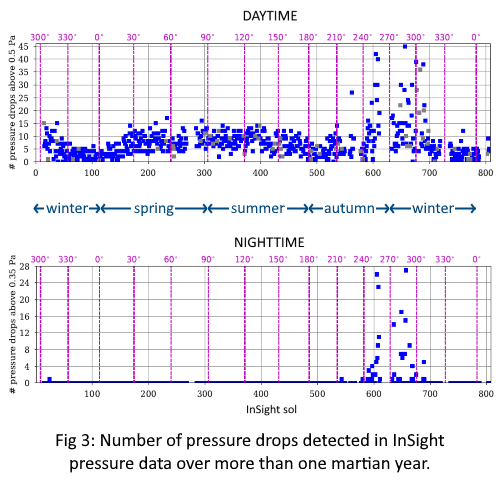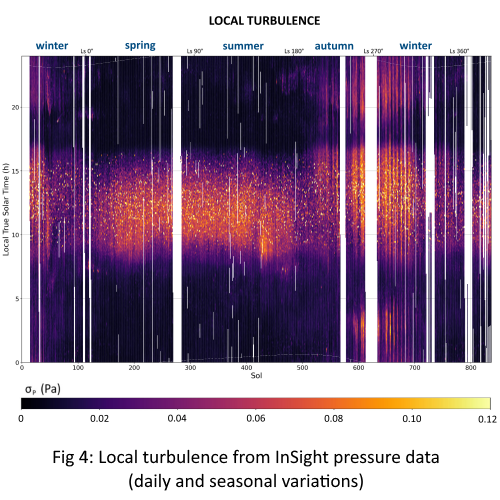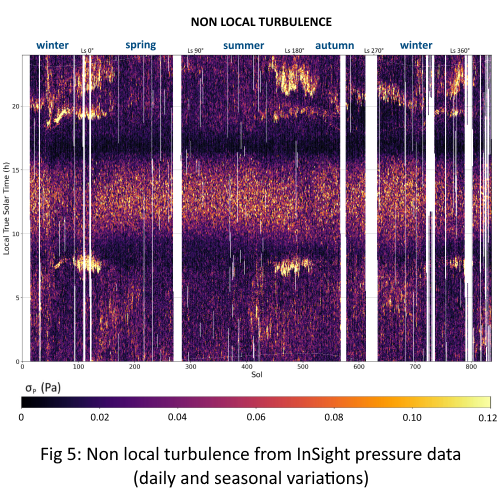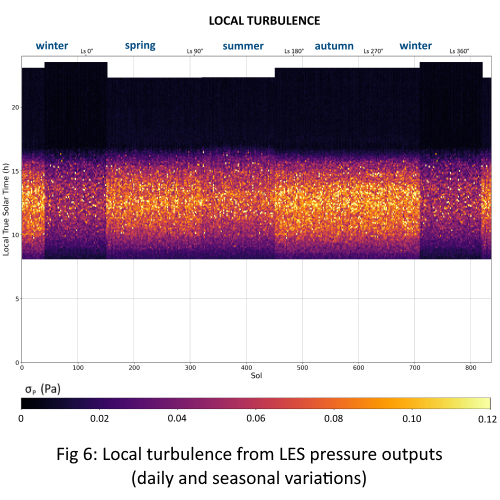Seasonal variability of Mars atmospheric turbulence studied from InSight high-frequency pressure measurements
- 1LMD/IPSL, CNRS, Sorbonne Université, Paris, France (audrey.chatain @ lmd.ipsl.fr)
- *A full list of authors appears at the end of the abstract
I- Introduction
The Martian surface is prone to atmospheric turbulence. Its thin atmosphere allows strong near-surface temperature gradients, especially during daytime, which result in conductive and convective instabilities in the Planetary Boundary Layer1. Atmospheric turbulence have different forms: convection cells during daytime and possibly convection rolls during the night, vortexes, waves or local turbulence. These phenomena induce high-frequency variations in the atmospheric pressure, wind and temperature, with different time scales. Most processes happen during the day, and are sensitive to seasons. On the opposite, nighttime conditions at the surface of Mars are usually highly-stable, though not much studied.
The InSight NASA mission, arrived on Mars in November 2018, recently brought new knowledge on surface atmospheric turbulence. InSight is the first lander operating an advanced geophysical station on Mars. It also has many accurate meteorological sensors and acts as a fixed weather station. Previous studies on the first 400 sols of the mission2,3 observed a high vortex activity during the day, though no detection of dust devils, detected nigttime gravity waves, and discovered the presence of a quiet regime 2 to 4 hours after sunset, which they attributed to the development time of the nocturnal low-level jet.
The aim of this work is to complete the study the atmospheric turbulence measured by the InSight mission over more than one Martian year and investigate its diurnal and seasonal variations. We observe many unexpected events with the arrival of autumn, with a burst of daytime vortexes, the apparition of nighttime vortexes and the development of a nighttime local turbulence nearly as intense as during daytime. Observational results are afterwards compared to Large Eddy Simulation (LES) outputs to bring new insights on the origin of the turbulent phenomena observed.
II- Investigation of the atmospheric turbulence with InSight pressure data
II.1- Vortexes
Previous studies4,5 observed vortexes during the first 400 sols of the mission, corresponding to a half year, spanning from the end of northern winter to midsummer. We extended their study to more than a complete Martian year. Vortexes are detected in the pressure data as sudden pressure drops of 0.1 to 10 Pa amplitude. We used the same detection algorithm as described in 4.
II.2- Local and non-local turbulence
Aside from vortexes, atmospheric turbulence can be observed through high-frequency pressure variations. We classified the turbulent phenomena in two groups depending on their timescales. ‘Local turbulence’ is due to small scale and high frequency phenomena (<100s), while ‘non-local turbulence’ is linked to larger structures (e.g. convection cells), which have longer timescales (100-500s). The typical frequency of non-local turbulence is similar to the one of peculiar structures such as gravity waves3, which are therefore included in our definition of non-local turbulence. Fig.1 and 2 are examples of investigation of local turbulence on two seasons, computed from a moving mean on 100s and a moving standard deviation on 500s.
III- InSight results
The comparison of the results given by vortexes and the two turbulences are given in Fig.3-4-5.



We observe that northern spring and summer define a very calm season. There is nearly no change from one day to another, very few non local turbulence at night and absolutely no nighttime vortexes and local turbulence.
On the opposite, the northern autumn brings a lot of turbulences, which continue into winter. We observe two different trends:
(T1) In early autumn and late winter a 50% decrease is observed in the daytime local turbulence and a small nighttime local turbulence appears. These are attributed to a solar flux decrease as many storms load the atmosphere with dust. The day surface temperature decreases, which inhibits the atmospheric turbulence. On the opposite, the night surface temperature increases and induces a strong increase of the low-level jet in the evening, which could trigger the apparition of nighttime turbulence. During this period, strong nighttime signals are also present in the non local turbulence, around 8h, 20h and 22h. They are attributed to gravity waves or bores3.
(T2) In between, from sols 530 to 710, a very different pattern is observed. The daytime local turbulence increases back, and the nighttime local turbulence increases up to values similar to the daytime signal, along with the formation of nighttime vortexes. We suspect the strong nocturnal low-level jet to be at the origin of an enhanced nighttime turbulence and the formation of nighttime vortexes. Pseudo-regular extinction patterns of 3 to 12 sols are present, and are perfectly correlated to high wind periods defined by baroclinic waves3.
IV- Large Eddy Simulations
We performed Large Eddy Simulations (LES) in different seasonal and wind conditions to investigate further the turbulent processes observed by InSight (see Fig.6). We used the model described in 6, and previously adapted to InSight landing site conditions in 4.

Turbulence results obtained with the LES in spring-summer conditions reproduce very well the observations by InSight. A major conclusion is that the model succeeded in creating daytime local turbulence, even with 25 m-large mesh grids. We observed that local turbulence increases with wind velocity, while wind has only minor effects on non local turbulence.
On the opposite, nighttime vortexes and local turbulence during the autumn-winter season are not reproduced by LES in the case of a constant altitude wind forced to 10 or 20 m/s. We will investigate further the possible effect of a wind profile. Nevertheless, we know that even for the study of Earth, LES have intrinsic difficulties simulating stable boundary layers, existing especially at night (due to mesh size limitation).
References
1Tillman J.Atm.Sc. 1994
2Spiga Space Sc.Rev. 2018
3 Banfield Nature Geoscience 2020
4 Spiga JGR 2021
5 Lorenz Icarus 2021
6 Spiga Q.J.R.Meteorol.Soc. 2010
APSS pressure sensor and TWINS team
How to cite: Chatain, A. and Spiga, A. and the InSight team: Seasonal variability of Mars atmospheric turbulence studied from InSight high-frequency pressure measurements, European Planetary Science Congress 2021, online, 13–24 Sep 2021, EPSC2021-290, https://doi.org/10.5194/epsc2021-290, 2021.

